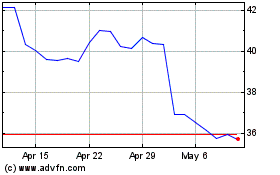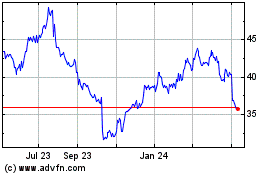Baxter International Inc. (NYSE:BAX) today announced the
presentation of Phase III clinical data evaluating the safety and
efficacy of GAMMAGARD LIQUID 10% [Immune Globulin Infusion (Human)]
for the treatment of multifocal motor neuropathy (MMN). The data
were presented during a Clinical Trials Forum at the 64th annual
meeting of the American Academy of Neurology (AAN) in New Orleans,
La., and formed the basis for a regulatory filing seeking an
indication to treat the condition.
The Phase III, randomized, double-blind, placebo-controlled,
cross-over, multi-center study evaluated whether GAMMAGARD LIQUID
was superior to placebo in preserving muscle grip strength and
preventing progression of disability in 44 patients with MMN.
Patients completed five study phases, each 12 weeks long (three
open-label phases with GAMMAGARD LIQUID and two double-blind,
cross-over treatment phases with GAMMAGARD LIQUID or placebo), with
an average monthly dose of 1.2 g/kg body weight. This is the
largest randomized clinical trial of patients with MMN to date. MMN
is associated with a progressive, asymmetric limb weakness most
often affecting the upper limbs, which can lead to significant
difficulty with simple manual tasks.
GAMMAGARD LIQUID met its two primary efficacy endpoints,
demonstrating a 3.75 percent increase in mean grip strength of the
more affected hand during treatment, as compared to a 31.38 percent
decrease in mean grip strength with placebo administration. The
study also found that a greater proportion of patients who received
placebo experienced progressive disability, as assessed by the
Guy’s Neurological Disability Score compared to those receiving
GAMMAGARD LIQUID (35.7% vs. 11.9%, respectively).
If study participants experienced intolerable interference with
daily activities, the study allowed them to switch from placebo to
GAMMAGARD LIQUID. The majority of patients on placebo (69%)
required an accelerated switch before 12 weeks, with some in as few
as seven days.
''MMN is a debilitating progressive disease and this development
program helped assess the potential for new uses for GAMMAGARD
LIQUID. If approved by the regulatory authorities, GAMMAGARD LIQUID
will become the first immunoglobulin treatment available for
patients with MMN in the United States,'' said Prof. Hartmut J.
Ehrlich, M.D., vice president of global research and development in
Baxter’s BioScience business.
No deaths or unexpected serious adverse events related to study
product occurred. The most commonly reported adverse reactions
(reported in five or fewer percent of subjects) were headache and
muscular weakness. The proportion of infusions associated with
headache was 2.1 percent with GAMMAGARD LIQUID and 2.3 percent with
placebo. The proportion of infusions associated with muscular
weakness was 0.4 percent with GAMMAGARD LIQUID and 0.8 percent with
placebo.
The prevalence of MMN is estimated at one in approximately
100,000 people. Baxter has been granted Orphan Drug Designation in
pursuit of this indication in the United States, which includes
treatments for diseases that affect fewer than 200,000 people.
Baxter filed a supplemental biologics license application with the
U.S. Food and Drug Administration (FDA) in December 2011 seeking an
indication for GAMMAGARD LIQUID to include MMN. The product,
marketed as KIOVIG outside the United States and Canada, was
approved for the MMN indication in Europe in 2011.
About GAMMAGARD LIQUID
GAMMAGARD LIQUID is indicated as replacement therapy for primary
humoral immunodeficiency in adult and pediatric patients two years
of age or older.
This includes, but is not limited to, common variable
immunodeficiency (CVID), X-linked agammaglobulinemia, congenital
agammaglobulinemia, Wiskott-Aldrich syndrome, and severe combined
immunodeficiencies. GAMMAGARD LIQUID was originally approved by the
U.S. Food and Drug Administration (FDA) in September 2005 and is
approved in 51 countries worldwide.
IMPORTANT RISK INFORMATION
- Renal dysfunction, acute renal
failure, osmotic nephrosis, and death may occur with immune
globulin intravenous (IGIV) products in predisposed patients.
Patients predisposed to renal dysfunction include those with any
degree of pre-existing renal insufficiency, diabetes mellitus, age
greater than 65, volume depletion, sepsis, paraproteinemia, or
patients receiving known nephrotoxic drugs.
- Renal dysfunction and acute renal
failure occur more commonly in patients receiving IGIV products
containing sucrose. GAMMAGARD LIQUID does not contain
sucrose.
- For patients at risk of renal
dysfunction or failure, administer GAMMAGARD LIQUID at the minimum
infusion rate practicable.
Prior to administering GAMMAGARD LIQUID, ensure that patients
with pre-existing renal insufficiency are not volume depleted. For
patients over 65 years of age or judged to be at risk for renal
dysfunction or thrombotic events, GAMMAGARD LIQUID must be
administered at the minimum infusion rate practicable. In such
cases, the maximal rate should be less than 3.3 mg/kg/min (<
2mL/kg/hr), and consider discontinuation of administration if renal
function deteriorates.
GAMMAGARD LIQUID is contraindicated in patients who have had a
history of anaphylactic or severe systemic hypersensitivity
reactions to the administration of human immune globulin.
GAMMAGARD LIQUID is contraindicated in IgA-deficient patients
with antibodies to IgA and a history of hypersensitivity.
Anaphylaxis has been reported with the intravenous use of
GAMMAGARD LIQUID and is theoretically possible following
subcutaneous administration.
Severe hypersensitivity reactions may occur, even in patients
who had tolerated previous treatment with human normal immune
globulin.
Hyperproteinemia, increased serum viscosity, and hyponatremia
may occur in patients receiving GAMMAGARD LIQUID.
Thrombotic events, including myocardial infarction, cerebral
vascular accident, deep vein thrombosis, and pulmonary embolism
have been reported in association with intravenous use of GAMMAGARD
LIQUID. Thrombotic events have also been reported with subcutaneous
administration of immune globulin. Patients at risk for thrombotic
events include those with a history of atherosclerosis, multiple
cardiovascular risk factors, advanced age, impaired cardiac output,
coagulation disorders, prolonged periods of immobilization,
obesity, diabetes mellitus, acquired or inherited thrombophilic
disorder, a history of vascular disease, or a history of a previous
thrombotic or thromboembolic event.
Aseptic Meningitis Syndrome may occur with IGIV treatment, and
has been reported with intravenous use of GAMMAGARD LIQUID.
Discontinuation of IGIV treatment has resulted in remission of AMS
within several days without sequelae.
GAMMAGARD LIQUID contains blood group antibodies which may act
as hemolysins and induce in vivo coating of red blood cells (RBC)
with immune globulin. Acute intravascular hemolysis has been
reported, and delayed hemolytic anemia can develop due to enhanced
RBC sequestration.
Non-cardiogenic pulmonary edema (TRALI) has been reported in
patients following treatment with IGIV products, including
GAMMAGARD LIQUID.
GAMMAGARD LIQUID is made from human plasma. It may carry a risk
of transmitting infectious agents, e.g., viruses, the variant
Creutzfeldt-Jakob disease (vCJD) agent, and theoretically, the
classic Creutzfeldt-Jakob disease agent. This also applies to
unknown or emerging viruses and other pathogens.
No cases of transmission of viral diseases or vCJD have been
associated with GAMMAGARD LIQUID.
Intravenous: The most serious adverse reaction seen during
intravenous treatment in the clinical trials was two episodes of
aseptic meningitis in one subject. The most common adverse
reactions (observed in ≥5% of subjects) were headache, pyrexia,
fatigue, rigors, nausea, chills, dizziness, vomiting, migraine
headache, pain in extremity, urticaria, cough, pruritus, rash, and
tachycardia.
Please review the GAMMAGARD LIQUID Prescribing Information for
full prescribing details.
http://www.baxter.com/products/biopharmaceuticals/downloads/gamLIQUID_PI.pdf
About Baxter International Inc.
Baxter International Inc., through its subsidiaries, develops,
manufactures and markets products that save and sustain the lives
of people with hemophilia, immune disorders, infectious diseases,
kidney disease, trauma, and other chronic and acute medical
conditions. As a global, diversified healthcare company, Baxter
applies a unique combination of expertise in medical devices,
pharmaceuticals and biotechnology to create products that advance
patient care worldwide.
This release includes forward-looking statements concerning the
potential use of GAMMAGARD LIQUID for the treatment of multifocal
motor neuropathy. The statements are based on assumptions about
many important factors, including the following, which could cause
actual results to differ materially from those in the
forward-looking statements: satisfaction of regulatory and other
requirements; actions of regulatory bodies and other governmental
authorities; and other risks identified in Baxter’s most recent
filing on Form 10-K and other SEC filings, all of which are
available on Baxter’s website. Baxter does not undertake to update
its forward-looking statements.
Baxter (NYSE:BAX)
Historical Stock Chart
From Mar 2024 to Apr 2024

Baxter (NYSE:BAX)
Historical Stock Chart
From Apr 2023 to Apr 2024
